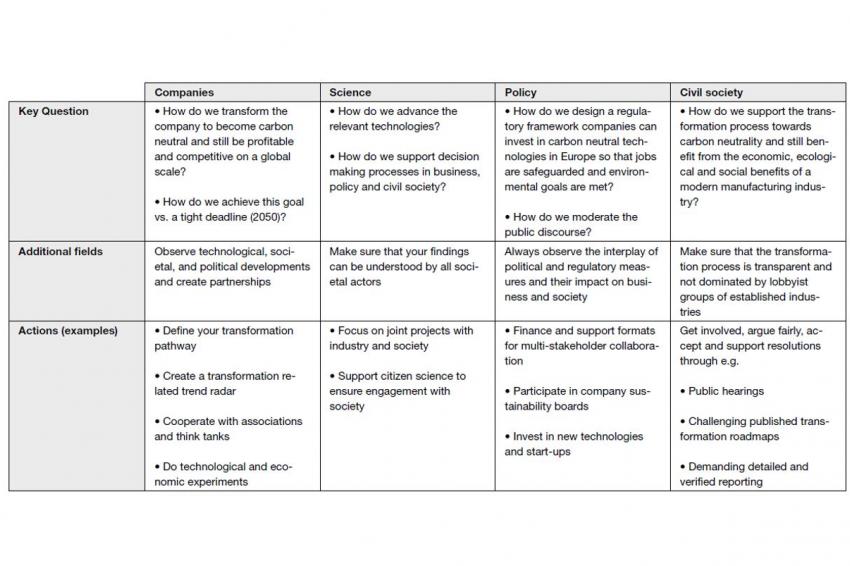CO2-Neutral Chemical Industry by 2050
The Challenge of an Industry Transformation, but a Challenge Worth Taking On
System changes of the scale of CO2 neutrality for a whole industry sector require a suitable attitude from decision makers — the whole system and not only the elements of the individual company need to be investigated and designed.
Major transformations call for long lead times and require consistent and persistent follow-through. The transformation needs to be supported by policy makers and civil society. It is all but clear whether enough value is created to justify the huge investments required and how new value generated is distributed among critical players and investors. We can learn valuable lessons from the current handling of the Corona pandemic as a multi-stakeholder effort and apply these observations to identify success factors for the transformation of the chemical industry to CO2 neutrality.
What Mindset to Start With?
The German chemical industry intends to be carbon neutral by 2050. Industry-level concepts have been published underlining that the creation of a CO2-neutral chemical industry would be potentially technically feasible within this space of time. The public debate now focusses more on how the transformation can be successfully designed and realized and does not question the desirability of the goal itself any longer.
Companies need to translate this vision into their specific context. But how should they frame the challenge? Should they only think about the decarbonization of their current activities (“renovate the building”) or should they think as well about the remodeling of their relations to other stakeholders such as suppliers, customers, energy providers, policy makers and civil society (“rethink the inside and the outside of the building”).
“Too many technological, economic,
regulatory and societal variables
on the path to CO2 neutrality still remain unclear.”
We believe that the broader view is necessary. A mindset is needed that focusses on the individual decarbonization strategy and integrates as well developments and activities from society, policy, science and other businesses into the considerations.
This broad, system-oriented mindset is necessary, because too many technological, economic, regulatory and societal variables on the path to CO2 neutrality still remain unclear.
“To achieve climate neutrality,
incremental technical changes are not sufficient,
but new technologies are required.”
Technological aspects: To achieve climate neutrality, incremental technical changes are not sufficient, but new technologies are required. But it is difficult to estimate when which technology will actually be available for large-scale industrial use and at what price. For many alternative technologies, large amounts of renewable electricity are a prerequisite. The ecological transformation of the chemical industry, thus, also requires a cross-sectoral approach, which must take into account new national and international infrastructures to be built.
Economic aspects: Many alternative technologies will not be competitive with conventional technologies without a global CO2 price, due to their higher production costs. For example, it is estimated that the production of green hydrogen by electrolysis will incur additional costs of 56 % to 178 % compared to steam reforming. Studies estimate the investment costs to be acceptable for society as a whole, but a challenge for individual companies. Against the backdrop of uncertain future conditions, companies must now assess whether and how they will change their business model and in which technologies they will invest. They must plan not only how to enter new technologies (entrepreneurial innovation), but also how to exit established technologies (entrepreneurial exnovation).
Regulatory issues: The regulatory framework faces a conflict of objectives: the policy measures chosen should maintain industry competitiveness and prevent industry leakage (carbon leakage). The measure of choice often cited is the introduction of a global carbon price. This would reflect the social costs of CO2 emissions and provide an incentive to avoid CO2 emissions. Decisions on the right policy mix have not yet been made.
„Companies need to plan their individual
transformation pathway as a part
of an encompassing industry sector transformation.”
Social aspects: The majority of the population expects businesses to actively contribute to climate protection. Decisions on new technologies need to take into account public acceptance, especially in the case of CCS (Carbon Capture and Storage), which may be still in doubt. But even then, if the general public basically approves of a technology, problems may occur during local implementation, as can be observed from time to time with the construction of new wind turbines (“not in my backyard” — NIMB — phenomenon). Societal support must therefore be secured time and again at different levels (regional, national, international) and among different target groups (e. g., experts vs. others; young vs. old).
The transformation is a complex endeavor with multiple influencing and interrelated factors. Companies may have to take decisions under considerable uncertainty because some technological, economic, regulatory and societal aspects may still be unclear at time of decision. Therefore, companies need to plan their individual transformation pathway as a part of an encompassing industry sector transformation.
Multi-Stakeholder Challenge
Companies in the chemical industry have to see the transformation process not only from a scientific and technical, but also from an economic and social perspective. They need to balance along the way to 2050 their environmental ambition with their economic goals (profitability, competitiveness) and social objectives (jobs). Policy makers focus especially on social goals (jobs in Europe) and intend to design a regulatory framework that supports companies in investing in carbon neutral technologies in Europe.
Here, a big challenge is to strike the right balance between preventing risks and accepting and managing those risks that are inherent to fundamental innovations. Science owns the responsibility to advance relevant technologies and to support decision making processes in business, policy and civil society. And civil society — a very diverse group — may want to make sure that the transformation process is transparent and not dominated by lobbyist groups of established industries.
Thus, multiple actors with potentially conflicting goals reflect about the best potential transformation pathway. In a decision-making model, the best option must be selected from a number of alternatives in the light of a set of objectives. With regards to the transformation, conflicts between stakeholders can be related to different elements of the decision model:
- Alternatives: What alternatives (technologies, policy instruments) are considered?
- Objectives: Which economic, ecological, social objectives are used for the evaluation of alternatives and how are they weighted?
- Benefits: Which benefit function is assumed? What environmental effect does a technology have? What are costs and benefits to companies and society?
- Timing: At what point in time should which decision be made? Does it make sense to delay decarbonization measures, because better technologies may be available in the future?
It is obvious that these questions are answered very differently by different stakeholders (companies, politicians, society). A multi-stakeholder collaboration is needed to align societal efforts (cf. figure). Companies from the chemical industry need to engage in cross-industry and cross-disciplinary collaboration and be active participants in the societal discourse to make sure that their perspective is sufficiently taken into account by other stakeholders.
Managing the related complex and sometimes new interfaces between a wide range of business partners, government authorities, academia, and external stakeholders is a management challenge on its own. These actors practically form a new ecosystem. Processes with the objective to generate value that benefits all stakeholders require all actors playing their role within this ecosystem constructively in a spirit of cooperation and co-ownership. Each party has to identify and assume its role and responsibility so that the whole ecosystem can mobilize and capture the necessary resources to deliver against the common objective of achieving CO2 neutrality. For managing roles and responsibilities of the four groups of stakeholders, we suggest following the approach of Marc Dreyer et al. to Responsible Innovation — the so called 4-Gears Model (Journal of Sustainability Research 2020;2(4):e200033).
A Vision Put into Action
“Converting the chemical industry
to CO2 neutrality asks for major redesigns
and changes of major parts of its technologies,
processes, assets, and structures.”
Converting the chemical industry to CO2 neutrality asks for major redesigns and changes of major parts of its technologies, processes, assets, and structures. Implementing these transformations requires major investments in the chemical industry. Their execution commands long lead times and requires consistent and persistent follow-through — just imagine the related permits, stakeholder management, construction, logistics issue. Given the size and impact of these changes, more stakeholders from outside the chemical industry (like consumer associations, policy makers, and NGOs) have to be involved earlier and more deeply. This will demand more efforts and resources of all parties involved and potentially may slow down the transformations.
Net, the journey to CO2 neutrality resembles a marathon. But getting to the finish line by 2050 requires sprint speed.
The conversion of the chemical industry to CO2 neutrality poses a challenge only comparable to the evolution of chemistry from a field of research and discovery of individual scientists to the industrial chemistry sector of the 20th century. Looking for other examples, the development of a completely new family of vaccines against Corona with the highest speed possible comes to mind. Considering its success, what learnings may be applied to the transformation to CO2 neutrality? Here a couple of suggestions:
Start with crystal-clear objectives shared by all key players involved. For developing a vaccine against a raging pandemic, these goals are obvious. For the less pressing and perceptible need for CO2 neutrality, the final goal and especially the accepted milestones need to be precisely stated.
- Embrace uncertainty: Accept that success of your activities will depend upon developments of other actors in your ecosystem as well. Start nevertheless.
- Set many horses on the path to the finish line. This can be achieved by forming many and diverse teams utilizing different strategies. Betting on many options will increase chances of success.
- Manage risk proactively. Build resilience into the planning of resources and milestones against unexpected outcomes and put aside additional resources as a contingency reserve.
- Clearly differentiate between the development and the deployment and scale-up phase. These phases pose different challenges, require different resources, and have distinct dynamics.
- Throughout the whole project, manage expectations of key actors, in particular of stakeholders who lack the background for understanding the size of the challenge and its inherent complexity and risk.
The more downstream the projects move, the more difficult and demanding it becomes to adhere to the principles above. With success in sight, many teams are tempted to break away and race to the finish line for claiming victory for them alone — as the European Commission is experiencing in these days of deployment of Corona vaccines.
A Challenge Worth Taking On
Going after the ambitious goal of CO2-neutrality by the year 2050 will create new growth areas for European and German industry. Exports will receive new stimuli. Indeed, a recent survey by Accenture of European industrial companies estimates the value potential of decarbonization to be €200 billion per year, €40 billion for the chemical industry alone, according to the Accenture survey.
Of course, carbon tax and its projected increases play a critical role here. But all in all, European industrial companies underestimate the perceived value of decarbonization among their customers and affected consumers. Decarbonization, thus, can be seen as a significant business opportunity for Europe and in particular Germany. Germany’s deep-rooted engineering and science culture may serve to demonstrate thought leadership, and its high technical, engineering, and scientific competence in chemistry and complex production systems (‘Verbund’ approach) can generate significant societal benefits.
Authors:
Joachim von Heimburg und Hannes Utikal, VCW - Vereinigung Chemie und Wirtschaft
_________________________
The Combination of Chemistry and Economics
The Vereinigung für Chemie und Wirtschaft (Association for Chemistry and Economics) is a section of the Gesellschaft Deutscher Chemiker (GDCh, German Chemical Society. Its mission is the combination of chemistry and economics and the formation of an international chemical industry network in order to investigate economic conditions of the chemical industry and to contribute to the discourse on industrial and technological development.
Downloads
Kontakt
GDCh - Fachgruppe VCW (Vereinigung für Chemie und Wirtschaft)
Varrentrappstr. 40-42
60444 Frankfurt am Main
Deutschland















